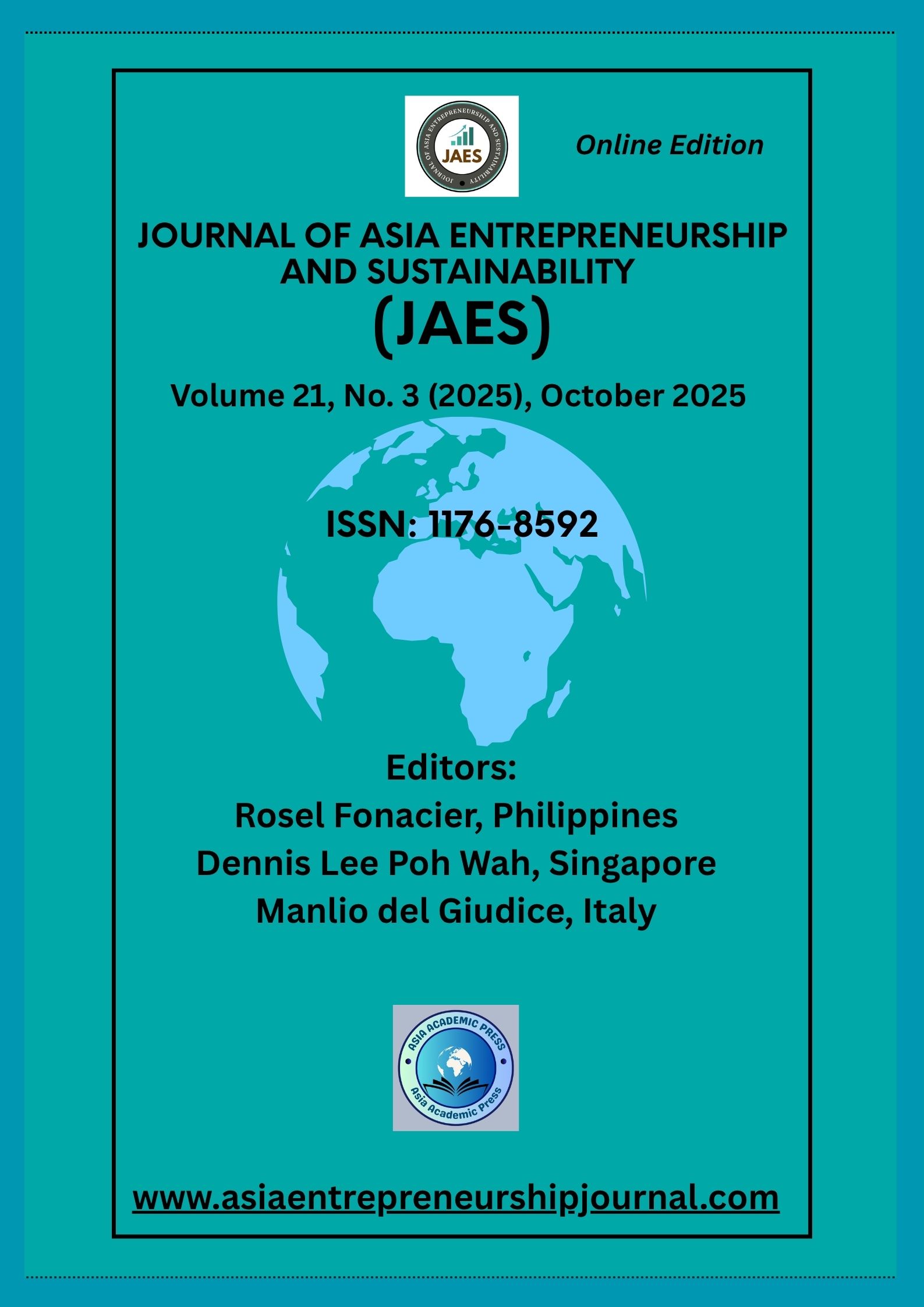Validation of Factors Affecting Customer Purchase Behavior in Digital Marketing: Insights from EFA and CFA
DOI:
https://doi.org/10.53555/jaes.v21i3.69Keywords:
Accessibility, Consumers, Delivery, Digital marketing, Price Offerings, Purchase Decision.Abstract
Purpose: The purpose of this study is to validate the key factors influencing customer purchase behavior in the context of digital marketing using Exploratory Factor Analysis (EFA) and Confirmatory Factor Analysis (CFA).
Design/ Methodology/Approach: In this study sample size was 400 respondents and used Quantitative research design.
Findings: The study employed Exploratory Factor Analysis (EFA), Confirmatory Factor Analysis (CFA), and Structural Equation Modeling (SEM) to validate and assess the impact of key digital marketing factors on customer purchase behavior. EFA identified five major dimensions—website design, price offerings, security and privacy, innovation, and delivery—as significant constructs influencing purchase decisions, while CFA confirmed the model’s validity, reliability, and goodness-of-fit. SEM results further revealed that all five factors positively and significantly affect customer purchase behavior, indicating that enhancing these digital marketing dimensions can effectively improve customers’ online purchase decisions.
Research Limitations: Numerous factors of Digital marketing have been included in this study, but we can investigate other factors influencing both Digital marketing and purchase decision in the future.
Practical Implications: With the Purpose to create the long term stability and competitive edge in the online marketplace, the findings also approach to focus on the customer requirement and fulfill the need as well. In addition to create the trust and also motivate the consumer to regularly interact with the Digital marketing platforms.
Social Implications: It emphasizing the social dynamics of digital interactions, trust, and community influence. It also promotes the benefit of social media, online feedback, to motivate the purchase decision.
Originality/Value: This study provide original contributions identifying the factors affecting the purchase decision via digital marketing using advanced analytical methods such as Structural Equation Modeling (SEM).
Article Type: Research paper
Funding Statement: No grant funding was received.
References
[1] ASSOCHAM. (2016). E-Commerce Industry will cross $38 bln mark by 2016; Indian e-commerce market set to grow by 67% in 2016: Study. Retrieved from http://www.assocham.org/newsdetail.php?id=5427
[2] Bridges, E., & Florsheim, R. (2008). Hedonic and utilitarian shopping goals: The online experience. Journal of Business research, 61(4), 309-314.
[3] Bleier, A., Harmeling, C. M., & Palmatier, R. W. (2019). Creating effective online customer experiences. Journal of marketing, 83(2), 98-119.
[4] Brewer, P., & Sebby, A. G. (2021). The effect of online restaurant menus on consumers’ purchase intentions during the COVID-19 pandemic. International Journal of Hospitality Management, 94, 102777.
[5] Baubonienė, Ž., & Gulevičiūtė, G. (2015). E-commerce factors influencing consumers ‘online shopping decision. Social technologies,5(1), 62-73.
[6] Browne, M. W., & Cudeck, R. (1992). Alternative ways of assessing model fit. Sociological methods & research, 21(2), 230-258.
[7] Chang, M. K., Cheung, W., & Tang, M. (2013). Building trust online: Interactions among trust building mechanisms. Information & management, 50(7), 439-445.
[8] Comrey, A. L., & Lee, H. B. (2013). A first course in factor analysis. Psychology press
[9] Dastane, D. O. (2020). Impact of digital marketing on online purchase intention: Mediation effect of customer relationship management. Journal of Asian Business Strategy, DOI, 10, 142-158.
[10] Dash, G., & Chakraborty, D. (2021). Digital transformation of marketing strategies during a pandemic: Evidence from an emerging economy during COVID-19. Sustainability, 13(12), 6735.
[11] Devaraj, S., Fan, M., & Kohli, R. (2006). Examination of online channel preference: using the structure-conduct-outcome framework. Decision Support Systems, 42(2), 1089-1103.
[12] Erdoğmuş, İ. E., & Cicek, M. (2012). The impact of social media marketing on brand loyalty. Procedia-Social and behavioral sciences, 58, 1353-1360.
[13] George, D., & Mallery, P. (2018). Reliability analysis. In IBM SPSS statistics 25 step by step (pp. 249-260). Routledge
[14] Hu, L. T., & Bentler, P. M. (1999). Cutoff criteria for fit indexes in covariance structure analysis: Conventional criteria versus new alternatives. Structural equation modeling: a multidisciplinary journal, 6(1), 1-55.
[15] Hair Jr, F., Gabriel, M. L., & Patel, V. K. (2014). AMOS covariance-based structural equation modeling (CB-SEM): Guidelines on its application as a marketing research tool. REMark: Revista Brasileira de Marketing,13(2)
[16] Fortes, N., Rita, P., & Pagani, M. (2017). The effects of privacy concerns, perceived risk and trust on online purchasing behaviour.International Journal of Internet Marketing and Advertising, 11(4), 307-329.
[17] Field, M., & Golubitsky, M. (2009). Symmetry in chaos: a search for pattern in mathematics, art, and nature. Society for Industrial and Applied Mathematics.
[18] Hutcheson, G. D., & Sofroniou, N. (1999). The multivariate social scientist: Introductory statistics using generalized linear models.
[19] Izogo, E. E., & Jayawardhena, C. (2018). Online shopping experience in an emerging e-retailing market. Journal of Research in Interactive Marketing, 12(2), 193-214.
[20] Jaiswal, S., & Singh, A. (2020). Influence of the determinants of online customer experience on online customer satisfaction. Paradigm, 24(1), 41-55.
[21] Jadhav, V., & Khanna, M. (2016). College students’ online buying behavior: a focus group study. Journal of Business and Management,18(6), 21-24.
[22] Jöreskog, K. G. (2007). Factor analysis and its extensions. Factor analysis at, 100, 47-77
[23] Katta, R. M. R., & Patro, C. S. (2017). Influence of perceived benefits on consumers' online purchase behaviour: an empirical study.International Journal of Socio technology and Knowledge Development (IJSKD), 9(3), 38-64.
[24] Katta, R. M. R., & Patro, C. S. (2020). Consumers' perceived value in internet shopping: an empirical study. International Journal of Customer Relationship Marketing and Management (IJCRMM), 11(2), 17-36.
[25] Katta, R. M. R., & Patro, C. S. (2017). Influence of perceived benefits on consumers' online purchase behaviour: an empirical study.International Journal of Sociotechnology and Knowledge Development (IJSKD), 9(3), 38-64.
[26] Katta, R. M. R., & Patro, C. S. (2016). Online Shopping Behavior: A Study of Factors Influencing Consumer Satisfaction on Online viz-a-viz Conventional Store Shopping.International Journal of Sociotechnologyand Knowledge Development (IJSKD), 8(4), 21-36.
[27] Khristianto, W., & Suyadi, I. (2012). THE INFLUENCE OF INFORMATION, SYSTEM, AND SERVICE ON CUSTOMER SATISFACTION AND LOYALTY IN ONLINE SHOPPING OF FORUM JUAL BELI KASKUS. US, MALANG REGION.International Journal of Academic Research,4(2).
[28] Lim, Y. J., Osman, A., Salahuddin, S. N., Romle, A. R., & Abdullah, S. (2016). Factors influencing online shopping behavior: the mediating role of purchase intention. Procedia economics and finance, 35, 401-410.
[29] Moolla, A. I., & Bisschoff, C. A. (2013). An empirical model that measures brand loyalty of fast-moving consumer goods. Journal of economics, 4(1), 1-9.
[30] Nambisan, P., & Watt, J. H. (2011). Managing customer experiences in online product communities. Journal of Business Research, 64(8), 889-895.
[31] Oré Calixto, S. (2021). The effect of digital marketing on customer relationship management in the education sector: Peruvian case.
[32] Patro, C. S. (2019). Influence of Perceived Benefits and Risks on Consumers' Perceived Value in Online Shopping: An Empirical Study. International Journal of Applied Behavioral Economics (IJABE), 8(3), 12-36.
[33] Patro, C. S. (2017). Consumer attitude and loyalty in online shopping environments: A study of facets driving shoppers towards e-stores. International Journal of Cyber Behavior, Psychology and Learning (IJCBPL), 7(3), 57-72.
[34] Patro, C. S. (2018). Predicting Consumers' Acceptance of Online Shopping on the Internet: An Empirical Study. International Journal of Cyber Behavior, Psychology and Learning (IJCBPL), 8(1), 33-60.
[35] Patro, C. S. (2022). Buyer Insight and Satisfaction on E-Store Shopping. International Journal of Cyber Behavior, Psychology and Learning (IJCBPL), 12(1), 1-13.
[36] Patro, C. S. (2023). Consumers' digital shopping experience: a study of the factors influencing purchase decision. International Journal of E-Business Research (IJEBR), 19(1), 1-17.
[37] Rao, K. R. M., & Patro, C. S. (2017). Shopper's stance towards web shopping: An analysis of students opinion of India. International Journal of Online Marketing (IJOM), 7(3), 42-54.
[38] Rita, P., Oliveira, T., & Farisa, A. (2019). The impact of e-service quality and customer satisfaction on customer behavior in online shopping. Heliyon, 5(10).
[39] Soares, A. M., Camacho, C., & Elmashhara, M. G. (2022, April). Understanding the impact of chatbots on purchase intention. In World conference on information systems and technologies (pp. 462-472). Cham: Springer International Publishing.
[40] Shi, Z., Zhang, C., & Wu, L. (2020). Sales or reviews, which matters more to consumer preference and online advertising?–evidence from eye-tracking and self-reporting. International Journal of Advertising, 39(8), 1274-1300.
[41] Sethuraman, P., & Thanigan, J. (2019). An empirical study on consumer attitude and intention towards online shopping. International Journal of Business Innovation and Research,18(2), 145-166.
[42] Tandon, U., & Ertz, M. (2022). Customer satisfaction towards online shopping by empirical validation of self-determination theory. In Handbook of Research on the Platform Economy and the Evolution of E-Commerce (pp. 177-203). IGI global.
[43] Wang, S., Cavusoglu, H., & Deng, Z. (2016). Early mover advantage in e-commerce platforms with low entry barriers: The role of customer relationship management capabilities. Information & Management, 53(2), 197–206. doi:10.1016/j.im.2015.09.011









